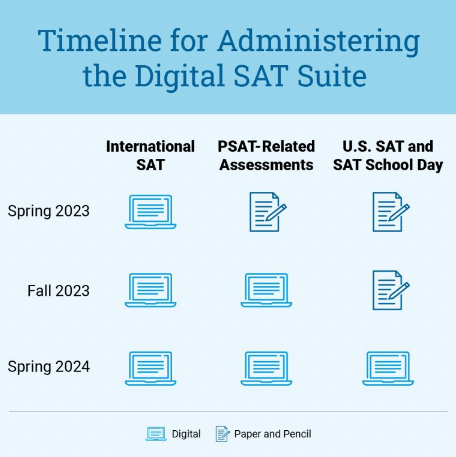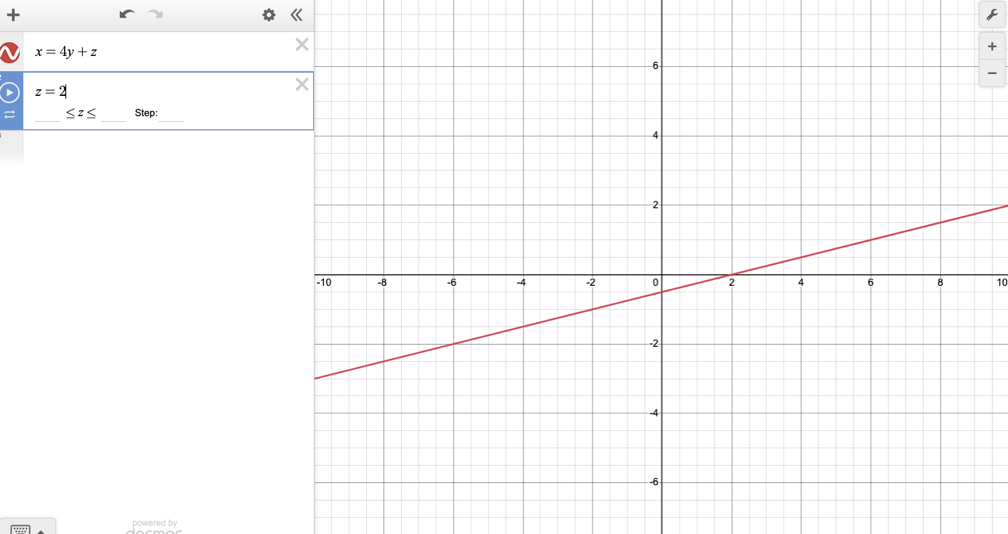 Within the changing landscape of college admissions, standardized testing in the form of the SAT or ACT remains an important factor. Created in 1926, the SAT has undergone many changes since its beginning, but it is about to face the biggest yet – it is soon to be exclusively administered digitally, in a test center or school. (The only exception is for students who require a paper-and-pencil accommodation, who will take a non-adaptive test the length of the current exam.) During its pilot run last November, 80% of students found the digital SAT to be less stressful than the traditional format.
Within the changing landscape of college admissions, standardized testing in the form of the SAT or ACT remains an important factor. Created in 1926, the SAT has undergone many changes since its beginning, but it is about to face the biggest yet – it is soon to be exclusively administered digitally, in a test center or school. (The only exception is for students who require a paper-and-pencil accommodation, who will take a non-adaptive test the length of the current exam.) During its pilot run last November, 80% of students found the digital SAT to be less stressful than the traditional format.
The digital format enables the College Board to make the exam section-adaptive, meaning that how a student does in the first module of each of the reading/writing and math sections determines the difficulty of the second module. Adaptive formats have been successfully implemented in graduate school testing, including the GRE, GMAT, and LSAT, and produce more reliable scoring.
When will the change occur?
The high school Class of 2025 (current sophomores) will be the first group of students in the United States to take the SAT in the new digital format in the spring of their junior year; the first administration will be in March 2024. Prior to that, the new digital PSAT 8/9, PSAT 10, and PSAT/NMSQT will be offered starting in the fall of 2023. International students will have access to the digital SAT in March 2023.
Here is the College Board’s graphic on the planned timeline:
What will change?
- The duration of the SAT will be reduced from three hours to two.
- The test will be section-adaptive using “multistage adaptive testing (MST)”. Each subject (verbal and math) will be divided into two sections and each student’s performance on the first section will determine the appropriate level of difficulty for the second section.
- The College Board has indicated that scoring will become more complex with each test question receiving a weighting, but details of the new scoring system have not yet been released.
- Students will be able to use their own device (laptop or tablet), a school-issued device, or one provided by the College Board.
- The test will include the following digital tools:
- Digital timer at the top of your screen
- “Elimination function,” where you can draw a line through answers you have eliminated and more clearly see the top contenders
- “Mark for review” function, where you can flag questions you would like to come back to
- Test scores will be available in a matter of days.
- Students will have more time per question.
- Reading and Writing
- Students have 64 minutes to complete 54 questions on the Reading and Writing section.
- Reading comprehension and grammar questions will be mixed together in the section.
- Questions will be more concise. Instead of lengthy reading passages with multiple follow-up questions, passages will be shorter (typically two to three sentences) with only one question connected to each.
- Sentence completions will return, after being eliminated in 2016
- Math
- Students have 70 minutes to complete 44 questions for the Math section.
- Graphing calculators may be used throughout the math portion of the exam.
- In addition, the test will have a built-in graphic calculator from Desmos. Become familiar with Desmos and its capabilities. Here is an example of a graph for the equation x=4y+z where z=2 – very cool!
What will stay the same? The SAT will continue to:
- Measure the skills and knowledge that students are learning in high school – skills related to reading, writing, and math.
- Consist of two sections, each scored on an 800-point scale, with the entire test remaining on a 1,600-point scale.
- Include the same Reference sheet for math formulas.
- Impose no penalty for incorrect answers.
- Be administered by a proctor in a testing center or school.
- Provide test accommodations for students who qualify.
- Coordinate with the National Merit Scholarship program.
The College Board has taken input from students and educators to create an adaptive test that meets the needs of the current population. Priscilla Rodriguez, Vice President of College Readiness Assessments at College Board said, “We’re not simply putting the current SAT on a digital platform—we’re taking full advantage of what delivering an assessment digitally makes possible.”
Our Recommendations
We recognize that each student has unique ways of approaching standardized tests as well as preferences for the best testing format. Given the upcoming change in the SAT, students should plan ahead:
- Take Diagnostic Practice Tests. Take a full-length SAT (in both paper and digital formats) and ACT. The College Board has released four digital practice tests through the Bluebook app. Many test prep companies have also developed their own in-house digital SAT practice tests.
- Decide which test and format you prefer. Take into account your instinctive preference for the pace and feel of the tests, in addition to your scores. If you prefer the SAT, decide whether the longer paper-based non-adaptive format is preferred, in which case you should plan to take the paper-based exam before the change: December 2023 will be the last time the paper version will be administered in the US.
- Begin test prep. We recommend that you start test prep about three months before your first test date. You have a variety of options: group classes, one-on-one tutoring, or self-study.
- Register in advance for the test. In order to have more options of test centers and test dates, register as soon as you know which test date suits you the best.
At Collegiate Gateway, we are eager to share our expertise and guide you on your admissions strategy and the path to your “best-fit” college. Please don’t hesitate to reach out so we can support you in this exciting process!
Check out our events page for future college admissions presentations.


